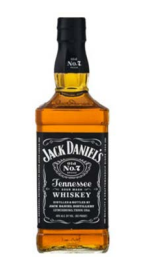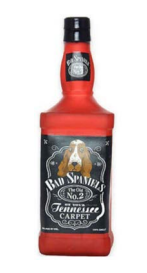A Win for Trademark Owners: The Supreme Court’s Ruling in Jack Daniel’s Properties Inc. v. VIP Products
June 12, 2023In Jack Daniel’s Properties Inc. v. VIP Products, the Supreme Court unanimously vacated the US Court of Appeals for the Ninth Circuit’s decision that a dog toy created by VIP Products parodying the Jack Daniel’s trademark and trade dress was protected by the First Amendment. The Court’s decision reined in the First Amendment exception in situations where parody or other expressive use is being used as a source identifier (i.e., as a trademark).
Background
The dog toy at the subject of this case was a play on the Jack Daniel’s whiskey bottle, with the words “Jack Daniel’s” replaced with “Bad Spaniels” and “Old No. 7 Brand Tennessee Sour Mash Whiskey” swapped for “The Old No. 2 On Your Tennessee Carpet.” The images from the Supreme Court’s opinion are as follows:


Jack Daniel’s owns trademarks in its bottle and in many of the words and graphics on the bottle label. After Jack Daniel’s demanded that VIP Products discontinue selling the toy, VIP filed suit and sought declaratory judgment that it neither infringed nor diluted the Jack Daniel’s trademarks. Jack Daniel’s responded by countersuing for infringement and dilution. VIP argued that the threshold Rogers test applied, which would result in dismissal of the case.
The Rogers test stems from the US Court of Appeals for the Second Circuit’s ruling in a case involving a film titled “Ginger and Fred,” which featured two fictional characters imitating actors Ginger Rogers and Fred Astaire.[1] Ginger Rogers objected to the use of her name in the title of the film, but the Second Circuit dismissed the case on the grounds that the title was an “artistic work” that had an “expressive element” and was protected by the First Amendment.[2]
As it has become known, the Rogers test states that when a use of a trademark is “expressive,” there is no trademark infringement unless (1) the use of the mark “has no artistic relevance to the underlying work” or (2) the use of the mark “explicitly misleads as to the source of the content of the work.”[3]
In the case of the VIP Products’ toy parody, the district court held that the Rogers test did not apply because the trademark was being used as a source identifier and applied the standard likelihood of confusion analysis to find infringement and also found dilution by tarnishment. However, the Ninth Circuit reversed, holding that the Rogers test applied because the dog toy “communicates a humorous message” and was thus an expressive work and there could be no dilution as the toy was a humorous and “non-commercial” use.[4]
SUPREME COURT OPINION
The Supreme Court reversed in a self-described “narrow” opinion focused on whether the challenged use is source-identifying.[5] The Court held first that for infringement, the Rogers test does not apply when an alleged infringer is using the trademark as a source identifier for its own goods—that is, “when the challenged use of a mark is as a mark.” Instead, the standard likelihood of confusion test for infringement should be used.
Similarly, for dilution, the Court held “that the noncommercial exclusion does not shield parody or other commentary when its use of a mark is similarly source-identifying.”
The Court opined that the Rogers test “offers an escape from the likelihood-of-confusion inquiry and a shortcut to dismissal” and is thus meant to be a “cabined doctrine.” It reasoned that if a mark conveys source, the Rogers test does not apply “even if the defendant is also ‘making an expressive comment,’ including a parody of a different product.” Instead, since the “defendant is still ‘mak[ing] trademark use of another’s mark,’ [it] must meet an infringement claim on the usual battleground of ‘likelihood of confusion.’” Otherwise, the Court reasoned, if Rogers provided protection every time there was a funny or humorous message, “Rogers might take over much of the world. For trademarks are often expressive.”
In addressing how free speech will be accounted for, the Court explained that Rogers is not necessary where trademark law is sufficient: “When a mark is used as a mark (except, potentially, in rare situations), the likelihood-of-confusion inquiry does enough work to account for the interest in free expression.”
PRACTICE POINTS
While reining in the Rogers test for “source-identifying” uses, that necessarily will shift the focus in cases to whether the challenged use qualifies as “source-identifying.” For the Supreme Court, the determination in this case was straightforward because VIP repeatedly claimed trademark and trade dress rights in the Bad Spaniels’ name and product design, had marketed the Bad Spaniels mark opposite its trademarked Silly Squeakers logo on its hangtag, and had a practice of registering as trademarks other of its toy names, such as “Jose Perro” (cf. Jose Cuervo) and “HeinieSniff’n” (cf. Heineken). However, not every case will be so clear, and it is likely that the fundamental question will now be whether the challenged use constitutes a trademark use.
As for the Rogers test itself, the Court did not reject it for uses that are not source-identifying and we can expect that it will continue to be invoked and applied. However, three justices suggested that it may have a limited lifespan.
Justice Neil Gorsuch issued a concurring opinion in which Justices Clarence Thomas and Amy Coney Barrett joined to issue a general warning to district courts that they “should handle [Rogers] with care.” Although it “remains for resolution another day,” the concurrence warned that “it is not entirely clear where the Rogers test comes from,” “it is not obvious that Rogers is correct in all its particulars,” and “the Solicitor General raises serious questions about [Rogers].”
One final point can be taken from Justice Sonia Sotomayor’s concurring opinion in which Justice Alito joined, in which they cautioned against the reliance on surveys in parody cases. They explain that when it comes to infringement involving parody, “[s]urvey answers may reflect a mistaken belief among some survey respondents that all parodies require permission from the owner of the parodied mark.” Justice Sotomayor cautioned that “[l]ike any other evidence, surveys should be understood as merely one piece of the multifaceted likelihood of confusion analysis.”
Contacts
If you have any questions or would like more information on the issues discussed in this LawFlash, please contact any of the following: